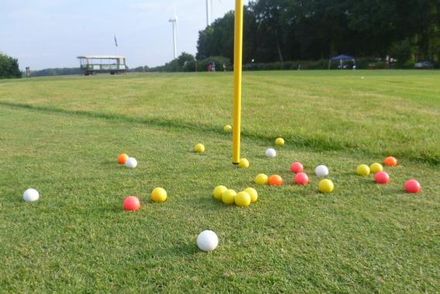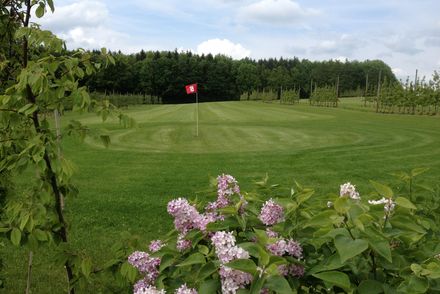For the construction of a SwinGolf course, an area (meadow, pasture or farmland) of at least 5 hectares (50,000 m² - for a 9-hole leisure facility) or approx. 10 hectares (18-hole competition course) plus areas for buildings and necessary infrastructure is required. For a football golf course 2-4 hectares a are required. This means that the area required is only about 15 - 20% of a "classic" golf course. The terrain should be halfway dry and/or have a drainage system. Access to the public sewerage system and power supply for the operating-buildings as well as access public roads for cars and delivery traffic are required, accessibility by public transport desirable.
Design of a SwinGolf course
The design of a SwinGolf course is quite uncomplicated and does not mean an irreversible intervention into nature. The existing topography is included as a course feature, no further excavations or embankments are planned, nor are any changes in the ground conditions, such as sand bunkers. A SwinGolf course therefore does not mean an irretrievable loss of agricultural land. Should the facility at some point no longer be in operation, it can be dismantled within a short period of time without extensive effort. Meadows outside the fairways (so-called roughs) can also be used for agricultural purposes during the playing season. From the construction-law point of view, an individual procedure is required for the construction of a SwinGolf course. The exact procedure must be discussed with the responsible authorities. This is where the professional support of SwinGolf-Deutschland GmbH throughout the approval process is helpful.
If the design and the set-up is based on approved standards, SwinGolf is a well-accepted form of soft-development in rural areas - especially from an environmental point of view.
Avoidance of "high-performance grass/seeds", reduced mowing
By sowing only meadow grasses typical of the region and dispensing with high-maintenance, high-performance grasses, a stable, resilient grass hub develops over time. It is largely robust against occasional periods of drought, pests and erosion. On the playing-areas and especially the nonplaying-areas, the grass may well grow a little longer. The intensity of mowing is therefore lower than in conventional golf.
No artificial irrigation
Sports fields usually have an irrigation and drainage system to protect the grass from drying out or rotting. This is not necessary with SwinGolf, even counterproductive, because it would reduce root formation. The local grasses are rather drought resistant. Although they turn brown in hot summers, they do not die off and sprout again when the weather is more favourable. This does not affect the playing activity. However, existing drainage systems remain in place to ensure year-round playability.
Environmentally friendly fertilisation, no use of pesticides or liquid manure
Artificially created grass sports fields are usually intensively fertilized. This is associated with the risk of leaching, and adjacent water bodies can be polluted. For SwinGolf facilities, however, a so-called "maintenance fertilization" is sufficient. The unplayed areas (roughs) are not fertilized at all. Pesticide use is not necessary. The application of liquid manure is also omitted and thus no odour nuisance is created.
This way, the construction and operation of a SwinGolf course represents a successful combination of ecology and economy.

![[Translate to Englisch:] Anlagenbetreiber Platz und Umwelt [Translate to Englisch:] Anlagenbetreiber Platz und Umwelt](/fileadmin/_processed_/c/b/csm_anlagenbetreiber_Platz-und-Umwelt_be024da79e.jpg)

